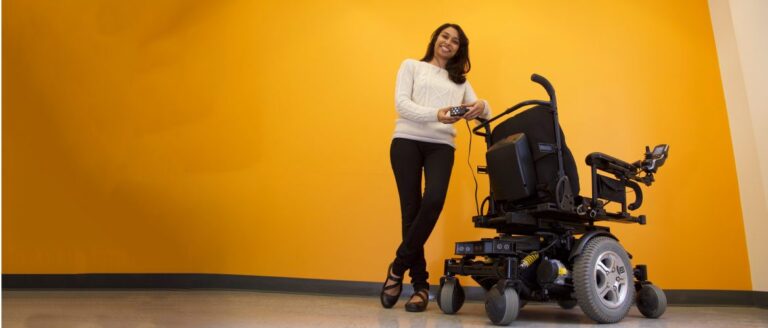
Listen to this Article



In 2006, a visit to a long-term care facility in Ontario, Canada, ignited a vision that would revolutionize mobility for wheelchair users. The staff’s apprehensions about accidents, property damage and collisions led to residents being denied access to motorized wheelchairs. Dr. Pooja Viswanathan observed residents confined to manual wheelchairs without the strength to self-propel. This realization marked the beginning of an innovative journey for her that has since transformed countless lives.
Motivated by this, Dr. Pooja initiated an investigation into how sensor technology could improve wheelchair safety. This led to collaboration with a research lab in Toronto, focusing on developing smart wheelchairs equipped with sensor technology to enhance safety and accessibility. The goal was to enable safe power mobility for individuals previously considered ineligible for it. This research culminated in her PhD thesis on smart wheelchair technology, involving the creation and testing of smart wheelchairs with numerous users. However, the frustration of a lack of commercial solutions persisted until the founding of Braze Mobility in 2016.
Innovative solution – The technology
Braze Mobility introduced the first and only blind spot sensor system for wheelchairs. These sensors can be added to any wheelchair, whether manual or motorized and offer three types of alerts: visual (lights), auditory (sounds), and tactile (vibrations). These alerts inform users of the proximity and location of obstacles, enhancing their ability to navigate safely.
Visual Alerts: The system features two rows of lights indicating obstacles in front and behind the wheelchair. The top row signifies front obstacles, while the bottom row highlights those behind. The lights change color based on the distance: yellow for obstacles within two feet and red for those within one foot. Users can customize the alert distances and even set up two different profiles through an accompanying app.
Auditory Alerts: Beeps accompany the red lights, serving as a crucial warning system for both the wheelchair user and others in the environment. These beeps ensure that users are alerted to close obstacles, prompting them to stop or adjust their path.
Tactile Alerts: Vibration pads can be placed in the backrest, seat cushion or armrests, providing tactile feedback. For instance, if an obstacle is on the right, the right side of the chair will vibrate, guiding the user away from potential collisions.
Success Stories and Impact
The impact of Braze Mobility’s technology is profound and far-reaching. Here are three diverse success stories:
1. Restoring independence in long-term care:
– A Canadian long-term care resident faced the prospect of losing her power wheelchair due to safety concerns. The staff restricted her mobility and also prohibited her from visiting the mall on her own. After trialing Braze Mobility’s sensors, she was able to navigate safely and the staff allowed her to retain her power wheelchair. Another issue was that she would damage the area beneath the sink in her bathroom with her wheelchair when attempting to use it. When equipped with the sensors, further damage was prevented because it would alert her when she was getting too close. Safe navigation around the facility and during mealtimes significantly improved her quality of life. She was also able to drive to the mall on her own.
2. A veteran with vision loss was empowered:
– A veteran and long-term power wheelchair user started losing his vision, leading to a confidence-shaking incident where he crashed into an empty baby stroller. The Veterans Affairs purchased Braze Mobility’s system for him and despite becoming legally blind, he maintained his independence. He even travelled out of state alone, using the sensors and a white cane. This story demonstrates how the right tools and training can empower individuals with disabilities.
3. Assisting a young girl with unique needs:
– A six-year-old girl using a head array to drive her chair faced challenges in navigating doorways. Braze Mobility’s system allowed her to center herself before backing up, eliminating damage to door frames. The system also taught her peers to respect her personal space, enhancing her independence and social interactions at school.
Customization and Support
One of Braze Mobility’s standout features is its adaptability. The system can be customized to fit any wheelchair model and tailored to meet the specific needs of the user. The app allows for adjustments in alert distances, feedback modalities and even the brightness and color of the lights to accommodate users with different sensory needs and preferences.
The company provides continuous support to clients, ensuring that any new requirements are met promptly.
Partnerships and Market Reach
Strategic partnerships have been instrumental in Braze Mobility’s success. Collaborations with organizations like AARP, Veterans Health Administration Innovation Ecosystem, Toyota Mobility Foundation, AGE-WELL NCE, Ontario Brain Institute, Centre for Aging and Brain Health Innovation, Access to Success, Ontario Bioscience Innovation Organization have expanded the reach and impact of their technology. These partnerships, along with participation in incubators and accelerators like Google for Startups, Techstars, Founder Institute, University of Toronto Entrepreneurship, have propelled the company forward.
Braze Mobility is revolutionizing wheelchair safety and independence. Their vision extends beyond power wheelchairs to include all personal mobility devices with sensor technology being a standard feature.
For inquiries or further details, visit Braze Mobility’s website and explore their range of transformative products.
